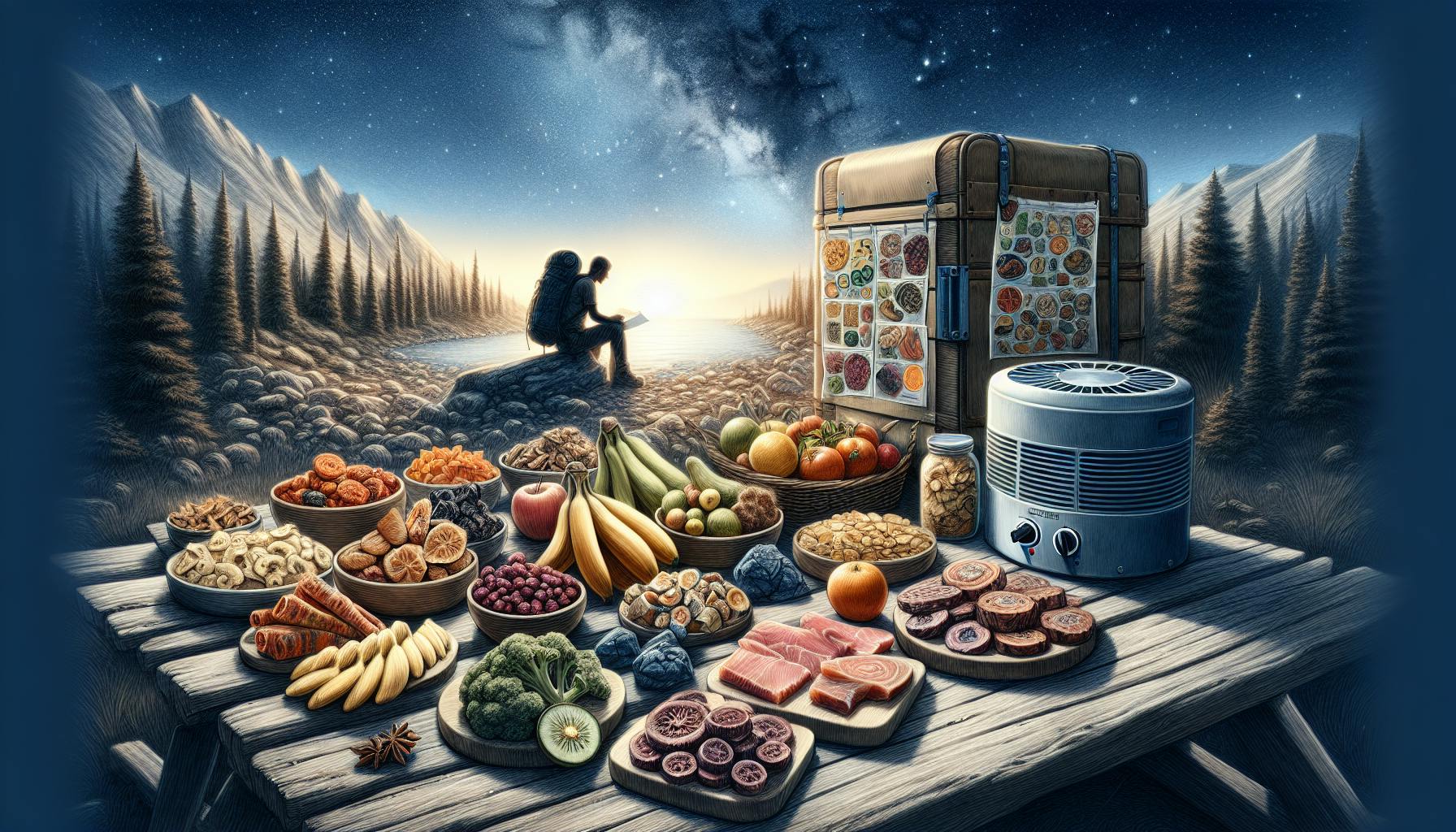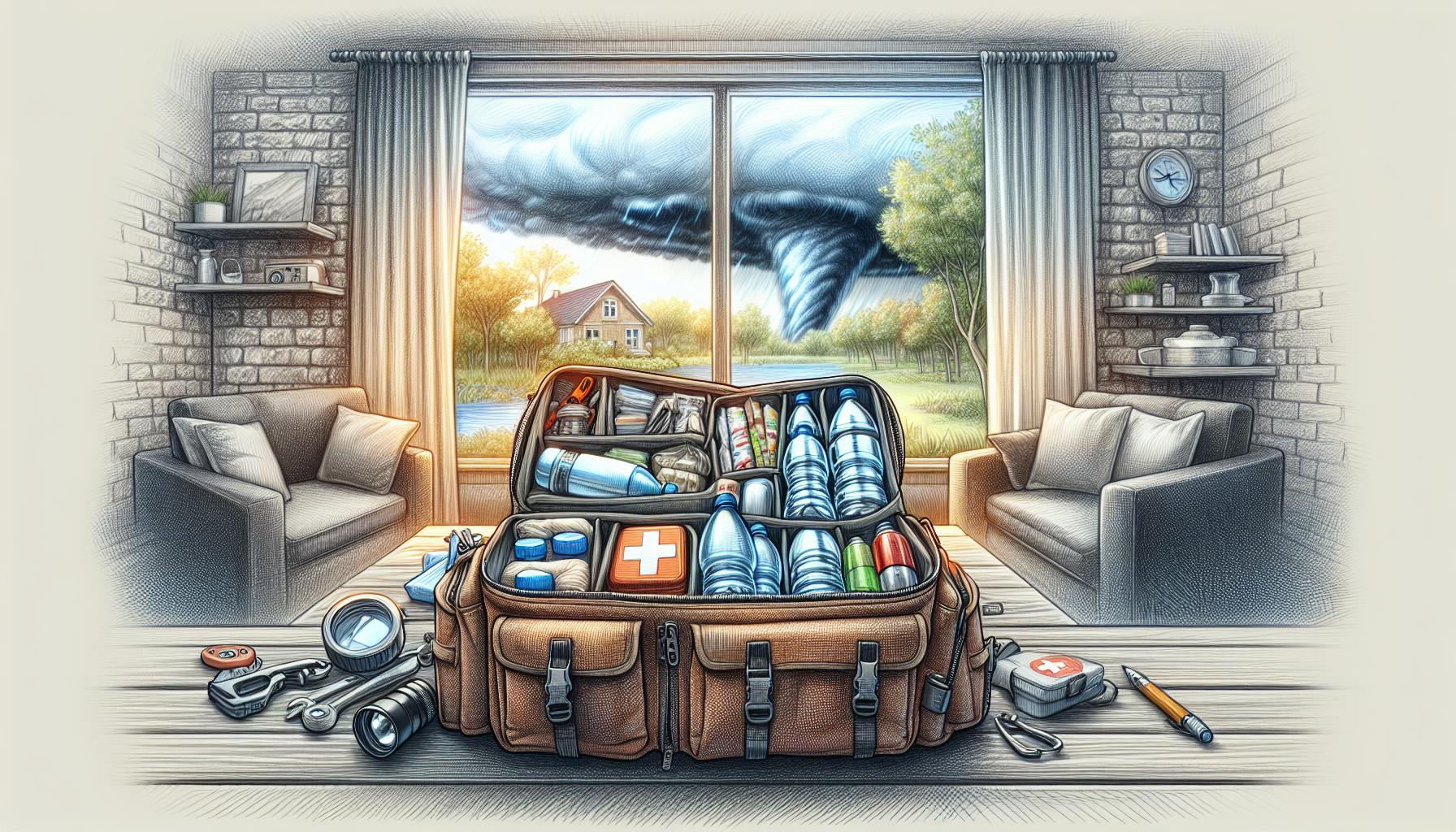Preparing for emergencies with a stockpile of canned goods is an prudent idea that most would agree is wise.
By understanding which canned items have the longest shelf life and provide balanced nutrition, you can create an emergency food supply to rely on when needed.
In this article, you'll discover the ideal canned foods to stockpile for emergencies, learning how to prioritize nutritional balance, shelf life, and variety in your prepper pantry.
Introduction to Building an Emergency Canned Food Stockpile
Building an emergency canned food stockpile is an important part of preparing for potential crises like natural disasters or extended power outages. Having a reserve supply of shelf-stable food ensures you and your family will have adequate nutrition if stores are inaccessible.
Understanding the Role of Canned Goods in an Emergency Preparedness Kit
Canned goods are essential items for an emergency food supply because of their long shelf life and nutritional balance. The canning process allows food to be shelf-stable for 1-5 years or longer, meaning canned items will be there when you need them most. Popular canned goods like beans, vegetables, fruits, meats, and soups provide protein, vitamins, minerals and calories to sustain you in an emergency situation.
The Advantages of Canned Foods for Long-Term Storage
Key reasons canned foods are ideal for emergency preparedness kits include:
-
Long shelf lives - Most canned goods last 2-5 years stored properly. Some can last even longer if stored in cool, dark places.
-
Nutritionally balanced - Canned fruits, vegetables, beans and meats provide carbs, protein, fiber and essential vitamins/minerals.
-
Affordable to stockpile - Buying canned goods in bulk is budget-friendly. Build reserves over time.
-
Convenient to store - Canned goods are shelf-stable and don't require refrigeration or special storage equipment.
Setting Objectives for Your Emergency Canned Food Supply
When building your canned food stockpile, set goals for:
-
Supply duration - Have at least a 2 week supply, optimally a 1-3 month supply.
-
Nutritional priorities - Stock up on essentials like beans, vegetables, fruits and lean proteins.
-
Budget - Allot monthly funds to buy canned goods when on sale. Compare prices between stores.
-
Storage capacity - Dedicate shelving for canned goods in a cool, dry place out of sunlight. Rotate stock as needed.
Following these guidelines will help you amass a well-rounded, nutritious emergency supply of canned goods.
What is the best canned food to stockpile?
When building an emergency canned food stockpile, it's important to have a variety of nutritious and non-perishable items that will sustain you and your family during a crisis. Here are some of the best types of canned foods to include:
Meats & Beans
Canned meats like tuna, chicken, salmon, and beef stew provide protein and nutrients. Canned beans are also great sources of plant-based protein, fiber, and minerals. Prioritize low-sodium options.
Fruits & Vegetables
Fruits and veggies packed in juice or water have essential vitamins. Go for lower-sugar fruits and a colorful mix of vegetables.
Grains & Comfort Foods
Ready-to-eat cereals, crackers, pasta, and rice can last a long time when properly stored. Comfort foods like soups, chili, and pasta sauce can lift spirits.
Milk & Nut Butters
Powdered or shelf-stable milk, almond milk, and nut butters supply calcium, vitamin D, healthy fats and protein.
When building your stockpile, pay attention to expiration dates, nutritional balance, and your family's needs and tastes. Aim for a diverse mix of canned goods that will sustain you both physically and emotionally. Check and rotate items regularly to ensure freshness and completeness.
What canned food lasts a long time?
When building your emergency canned food supply, focus on shelf-stable items with longer expiration dates to ensure your stockpile lasts.
Canned Food Shelf Life
- High acid canned foods like fruits, tomatoes, and juices will keep their best quality for 12-18 months.
- Low acid canned foods like meats, vegetables, and beans last 2-5 years.
- Properly stored canned goods can be safe to eat for even longer, but may degrade in texture, color, flavor, and nutrition over time.
Check expiration dates and only stock up on more recently packaged canned items with at least 12 months before expiry. Rotate your supply, using older cans first to maximize freshness.
While extremely rare, canned food stockpile botulism is a concern. This toxin develops from bacteria and spores that thrive in low-oxygen environments. To mitigate risk:
- Inspect cans for damage before opening. Bulges, rust, or leaks may indicate contamination.
- Never eat food from cans that spray or foam when opened.
- Boil suspect low-acid canned goods for 10 minutes before tasting.
Focus your emergency canned food supply on nutritious and safe-to-store options with longer shelf lives. Follow best practices for storage and inspection as well.
Should I stock up on canned food?
Stocking up on canned goods is an essential part of emergency preparedness. Canned foods have a long shelf life and provide nutrients when fresh foods are unavailable.
Here are some tips for building your canned food stockpile:
-
Buy foods you already eat and enjoy. Stick to familiar foods like canned tuna, salmon, chicken, soups, vegetables, beans, and fruits. This ensures nothing goes to waste.
-
Focus on nutritional balance. Choose low-sodium options when possible and include canned proteins, fruits, vegetables, beans, and soup for a well-rounded food supply.
-
Consider shelf life. Most unopened canned goods last 2-5 years, but always check expiration dates and use the FIFO (First In First Out) method.
-
Store properly. Keep cans in a cool, dark place and elevate off concrete floors if possible. Avoid temperature fluctuations that can impact shelf life.
-
Rotate stock. Use and replace items before they expire to keep your stockpile fresh. Mark purchase dates with a marker to track rotation.
Stocking up on canned goods ensures you have nutritious backup meals and ingredients in an emergency. Buy what you'll actually eat, store properly, and rotate to maximize shelf life. With some planning, canned goods can be an invaluable addition to your preparedness kit.
What happens to canned food after 20 years?
Most shelf-stable canned foods remain safe to eat indefinitely, as long as the cans are in good condition with no rust, dents, or swelling. This is because the canning process kills bacteria and seals out new contaminants.
Over time, canned food may lose some texture, color, and flavor, but it will still be safe to eat. For example, canned meats and fish may become darker, canned fruits and vegetables may soften, and flavors overall may become more muted. However, the nutrients will remain intact.
An important exception is canned goods with high fat content, such as spam, ham, and hearty stews. After about 5 years, the quality of these foods declines more rapidly. The fats can oxidize and go rancid, giving an unpleasant taste and odor.
So while most canned goods keep for decades, it's still best to use them within 1-5 years for peak quality. The older they get, the less appetizing they become. Be sure to check expiration dates if available, and inspect cans closely before opening. As long as the contents look and smell normal, they should still be perfectly safe to eat 20+ years later!
Properly stored canned goods are an excellent long-term addition to an emergency food stockpile. Just be aware that extremely old cans may not taste as vibrant as newer ones. But they can still provide critical nourishment in a crisis when fresh foods are unavailable.
sbb-itb-b932644
Nutritional Balance in Your Canned Food Stockpile
When building your emergency canned food stockpile, it's important to focus on nutritional balance. Choosing items with a variety of vitamins, minerals, fiber, and protein will help support health during a crisis.
Healthy Canned Items: Fruits and Vegetables
Fruits and vegetables are essential for obtaining vitamins, minerals, antioxidants, and fiber. Opt for low-sodium or no-salt-added canned varieties packed in natural juices or water whenever possible.
Some nutritious options include:
- Canned tomatoes, which provide lycopene, vitamin C and potassium
- Canned spinach and other leafy greens for vitamins A, C, K and folate
- Canned beans like kidney, black, or pinto beans offer protein, fiber, iron, magnesium and zinc
- Canned fruits like pineapple, peaches, pears and apples offer fiber, vitamin C and antioxidants
Aim for 1-2 servings of fruits and 3-5 servings of vegetables per day.
Protein-Rich Canned Beans and Legumes
Beans and legumes are excellent sources of plant-based protein. They also provide fiber, complex carbs, iron, magnesium and zinc.
Some healthy protein-packed options are:
- Kidney beans
- Black beans
- Chickpeas
- Lentils
Choose low-sodium or no-salt-added versions whenever possible. Rinse canned beans before use to remove excess sodium. Beans make versatile additions to soups, stews, chili and more.
Essential Nutrients from Canned Meats
Canned meats like tuna, salmon, chicken and ham can provide protein, healthy fats, iron, zinc and B vitamins. Go for lower-sodium options packed in water over oil or broth for maximum nutrition.
Some nutritious canned meat choices include:
- Water-packed tuna and salmon
- Canned chicken breast
- Lower-sodium sliced ham
Aim for 2-3 servings of protein foods like meat, fish, eggs or plant-based proteins daily.
Canned Soups and Stews for Hearty Meals
Soup and stew can provide calories, protein, vegetables and flavor. Look for options with quality ingredients and lower amounts of sodium per serving.
Some nutritious canned soup and stew selections include:
- Minestrone
- Lentil stew
- Split pea with ham soup
- Lower-sodium chili
One serving of soup or stew counts as 1 vegetable serving. These make convenient, shelf-stable meals to stock up on.
Focusing your stockpile on nutrient-dense fruits, veggies, beans, lentils, meats and soups will help support health in an emergency situation. Check expiration dates and aim to rotate out older canned goods to maximize freshness and nutritional quality over time.
Maximizing Shelf Life of Your Emergency Canned Food Supply
Selecting the Ideal Storage Conditions
When stockpiling canned goods for an emergency food supply, proper storage is key to maximizing shelf life. The ideal conditions are a cool, dry, dark space like a basement, closet or garage. Temperature and humidity fluctuations can shorten shelf life so avoid places that get too hot, cold, wet or have pest problems. Shelving, bins or storage containers help keep canned goods organized and easier to inventory.
Inventory Management: Organizing Pantry Staples
Use a spreadsheet, labels or bin system to catalog your canned good supplies by product, quantity, purchase date and expiration date. This makes regular inventory checks much simpler to track what needs to be used up and what needs restocking. Categorize similar items together on shelves and rotate stock using a "First In, First Out" system.
Implementing a FIFO Stock Rotation System
FIFO stands for First In, First Out, meaning you want to use older canned items before newer product. When restocking emergency supplies, put newer cans behind older cans. Always keep an eye on expiration dates and use up anything getting close. An easy rotation system is essential for freshness.
Regularly Check Expiration Dates
Check expiration or "best by" dates on canned goods at least every 3 months. Pull anything expired or close to expiration to the front of the storage area to get used immediately. Then reorder replacements to refill the stockpile. Be vigilant about date checking, as canned food can still spoil over very long storage durations. Proper rotation preserves quality.
Complementary Items for a Comprehensive Emergency Preparedness Kit
Round out your stockpile with other key supplies like water, tools, hygiene items and more.
Creating and Storing an Emergency Water Supply
Having an adequate supply of water is essential for survival. The general recommendation is to store at least one gallon of water per person per day for drinking and sanitation needs.
When building your emergency water supply, here are some tips:
- Store commercially bottled water or fill clean, food-grade plastic containers with tap water. Replace tap water every 6 months.
- Consider storing water treatment products like water purification tablets or bleach to disinfect water if needed. Follow instructions carefully.
- Store water containers in a cool, dark place to maximize shelf life. Avoid storing in direct sunlight or extreme temperatures.
- Label all water containers with the date and rotate stock to use oldest first.
An emergency water supply is a crucial complement to your canned food stockpile. Dehydration can set in quickly, so ensure access to adequate hydration.
Essential Tools for Food Preparation
To open, cook and serve your canned food, gather key tools including:
- Manual can openers - avoid electric openers reliant on power
- Fuel sources like camping stoves with fuel, matches/lighters
- Mess kits with pots, pans, plates, cups and cutlery
- Knives, cutting boards and other food prep items
Store tools properly to maintain functionality. Having what you need to open, cook and serve meals makes your canned food usable in an emergency.
Hygiene Products for Sanitation
Maintaining sanitation during an emergency helps prevent illness. Be sure to stockpile:
- Toilet paper, paper towels, trash bags
- Bar soap, toothpaste, shampoo
- Feminine hygiene products
- Bleach, disinfectants
- Backup gloves, face masks
Rotate stock to keep supplies fresh and usable. Proper sanitation complements your canned food stockpile.
Ensuring You Drink Enough Water Every Day
Alongside food, daily water intake is critical. During an emergency, consciously monitor your water consumption. Things that can help:
- Set reminders to drink water throughout the day
- Carry a refillable water bottle or hydration pack with you
- Drink a full glass of water with meals
- Have water purification tablets or filters ready
Dehydration causes fatigue, headaches, confusion and other symptoms. Ensure you drink at least the recommended daily amount of water per day.
Having complementary supplies makes your canned food stockpile more comprehensive and maximizes preparedness. Continue expanding your emergency kit over time.
Maintaining and Updating Your Canned Food Stockpile
Building a canned food reserve takes planning and gradual accumulation. Maintain your stockpile through regular audits and rotations.
Scheduling Regular Inventory Audits
Use calendar reminders to routinely audit canned good supplies, checking for damaged containers or expirations. This allows you to:
- Identify items that may be nearing expiration or showing early signs of spoilage
- Remove damaged cans that could compromise food safety
- Note where your reserves may be lacking in certain items or food groups
- Plan purchases to replenish stock as needed
Aim to audit every 3-6 months as a good rule of thumb.
Building Your Reserves Gradually
The key is to build your emergency canned food supply over time. Making smaller canned good purchases on grocery trips can help you accumulate reserves without breaking the bank.
- Set a goal number of extra canned items to buy each week
- Focus on nutritious and non-perishable varieties with long shelf lives
- Buy extra cans when items you regularly eat are on sale
- Slowly build diversity to cover different food groups
Staying Updated on Shelf Life Recommendations
With unopened, intact cans, foods that last a long time can often safely be consumed past printed expiration dates if properly stored. However, guidelines evolve so staying current is key.
- Check sites like StillTasty.com and publications from USDA
- Seek reputable sources on assessing canned food freshness
- Note storage times can vary by ingredients (e.g. tomatoes vs. chicken)
Updating your knowledge helps avoid wasting still-good canned reserves.
Incorporating New Healthy Canned Items
The market has grown beyond just beans and soup! Keep an eye out for new low-sodium options and canned varieties can provide you with essential nutrients like:
- Fruits packed in juice rather than syrup
- Vegetables with no added salt
- Salmon, tuna, and other fatty fish
- Whole grains like quinoa and brown rice
- Nut butters and hummus for protein
Adding diversity helps build nutritional balance in your stockpile over time.
Conclusion: Ensuring a Well-Stocked and Nutritious Canned Food Supply
Recap of Canned Food Stockpile Essentials
Having a diverse selection of canned goods with long shelf lives is crucial for emergency preparedness. When building your stockpile, focus on including canned fruits, vegetables, beans, meats, and seafood to meet nutritional needs. Favor options lower in sodium when possible. Check expiration dates regularly and replenish items as needed.
Final Thoughts on Emergency Preparedness
Maintaining an emergency food supply takes ongoing effort, but is essential preparation for unexpected events. Continue learning best practices for stockpiling shelf-stable foods. Revisit your stockpile every 6 months to take inventory, replace expired items, and fill any nutritional gaps. An up-to-date, balanced canned food reserve brings peace of mind that you and your family will stay nourished in an emergency.


